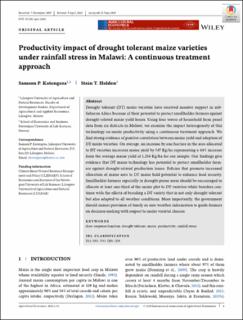| dc.contributor.author | Katengeza, Samson Pilanazo | |
| dc.contributor.author | Holden, Stein Terje | |
| dc.date.accessioned | 2022-02-25T07:37:39Z | |
| dc.date.available | 2022-02-25T07:37:39Z | |
| dc.date.created | 2021-04-21T14:08:51Z | |
| dc.date.issued | 2021 | |
| dc.identifier.citation | Agricultural Economics. 2021, 52 (1), 157-171. | |
| dc.identifier.issn | 0169-5150 | |
| dc.identifier.uri | https://hdl.handle.net/11250/2981347 | |
| dc.description.abstract | Drought tolerant (DT) maize varieties have received massive support in sub-Saharan Africa because of their potential to protect smallholder farmers against drought-related maize yield losses. Using four waves of household farm panel data from six districts in Malawi, we examine the impact heterogeneity of this technology on maize productivity using a continuous treatment approach. We find strong evidence of positive correlation between maize yield and adoption of DT maize varieties. On average, an increase by one hectare in the area allocated to DT varieties increases maize yield by 547 Kg/ha representing a 44% increase from the average maize yield of 1,254 Kg/ha for our sample. Our findings give evidence that DT maize technology has potential to protect smallholder farmers against drought-related production losses. Policies that promote increased allocation of maize area to DT maize hold potential to enhance food security. Smallholder farmers especially in drought-prone areas should be encouraged to allocate at least one-third of the maize plot to DT varieties while breeders continue with the efforts of breeding a DT variety that is not only drought tolerant but also adapted to all weather conditions. More importantly, the government should ensure provision of timely ex ante weather information to guide farmers on decision-making with respect to maize varietal choices. | |
| dc.language.iso | eng | |
| dc.title | Productivity impact of drought tolerant maize varieties under rainfall stress in Malawi: A continuous treatment approach | |
| dc.type | Peer reviewed | |
| dc.type | Journal article | |
| dc.description.version | publishedVersion | |
| dc.source.pagenumber | 157-171 | |
| dc.source.volume | 52 | |
| dc.source.journal | Agricultural Economics | |
| dc.source.issue | 1 | |
| dc.identifier.doi | 10.1111/agec.12612 | |
| dc.identifier.cristin | 1905622 | |
| cristin.ispublished | true | |
| cristin.fulltext | original | |
| cristin.qualitycode | 1 | |
